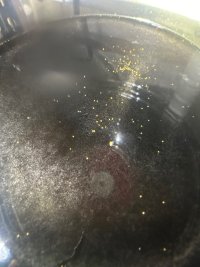You are using an out of date browser. It may not display this or other websites correctly.
You should upgrade or use an alternative browser.
You should upgrade or use an alternative browser.
Beer secondary - Yellow dot/spec
- Thread starter Haggus75
- Start date

Help Support Homebrew Talk - Beer, Wine, Mead, & Cider Brewing Discussion Forum:
This site may earn a commission from merchant affiliate
links, including eBay, Amazon, and others.
Hard to tell if that's little hop particles, or sprouting mold. If it's mold, I'm sure you'll see it progress in a unique way that will make it obvious it's not some hop particles.
Keep it and watch.
Keep it and watch.
I definitely wouldn't give up on it yet. Like micraftbeer said just watch and see what happens.
Side question though what was the reasoning for using a secondary? For the most part I would avoid using a secondary unless the style really required it (usually because it's a beer that needs a long time in the fermenter and I want to free up the primary). It's just another transfer that could introduce oxygen or another vessel that might not be fully sanitized.
Side question though what was the reasoning for using a secondary? For the most part I would avoid using a secondary unless the style really required it (usually because it's a beer that needs a long time in the fermenter and I want to free up the primary). It's just another transfer that could introduce oxygen or another vessel that might not be fully sanitized.
Haggus75
New Member
Thank you for your answer...
@Langerz Why the secondary??? First the recipe I followed was calling for a secondary (Needed to add Candi D-90) and before making beer I was making mead (and still making it). And with mead I always racked it in secondary. But after that experience I did come up with a question in my head, if going to secondary is really necessary. Next time I will probably leave it in primary.
@Langerz Why the secondary??? First the recipe I followed was calling for a secondary (Needed to add Candi D-90) and before making beer I was making mead (and still making it). And with mead I always racked it in secondary. But after that experience I did come up with a question in my head, if going to secondary is really necessary. Next time I will probably leave it in primary.
- Joined
- Mar 10, 2021
- Messages
- 2,719
- Reaction score
- 2,343
Did you use dry yeast? If so, maybe when you pitched, some of it got caught or stuck somewhere above the level of the wort. And for some reason when you racked to a secondary, it came loose and got in with the beer being transferred.
I also wouldn't use a secondary just because the recipe said too. I tend to think much of the secondary recommendations come from back in the revival of home brewing in the 80's and earlier when people were trying to rationalize the use of bright tanks by the commercial brewers. The main reason they used them is to get the beer out of the FV that they need to start the next batch. FV's are more complicated and expensive than bright tanks are for the commercial beer. That's why they don't just build another fermenter.
On the homebrew level, you can just leave everything in the primary FV and the same things will happen that happen in both your secondary FV and in the commercial brewers bright tank.
If you need your FV for another batch, another FV is a reasonable expense if you are doing that much volume of beer making.... on the homebrew level.
I also wouldn't use a secondary just because the recipe said too. I tend to think much of the secondary recommendations come from back in the revival of home brewing in the 80's and earlier when people were trying to rationalize the use of bright tanks by the commercial brewers. The main reason they used them is to get the beer out of the FV that they need to start the next batch. FV's are more complicated and expensive than bright tanks are for the commercial beer. That's why they don't just build another fermenter.
On the homebrew level, you can just leave everything in the primary FV and the same things will happen that happen in both your secondary FV and in the commercial brewers bright tank.
If you need your FV for another batch, another FV is a reasonable expense if you are doing that much volume of beer making.... on the homebrew level.
Similar threads
- Replies
- 10
- Views
- 479
- Replies
- 15
- Views
- 488
- Replies
- 25
- Views
- 1K
- Replies
- 10
- Views
- 833
- Replies
- 27
- Views
- 1K


